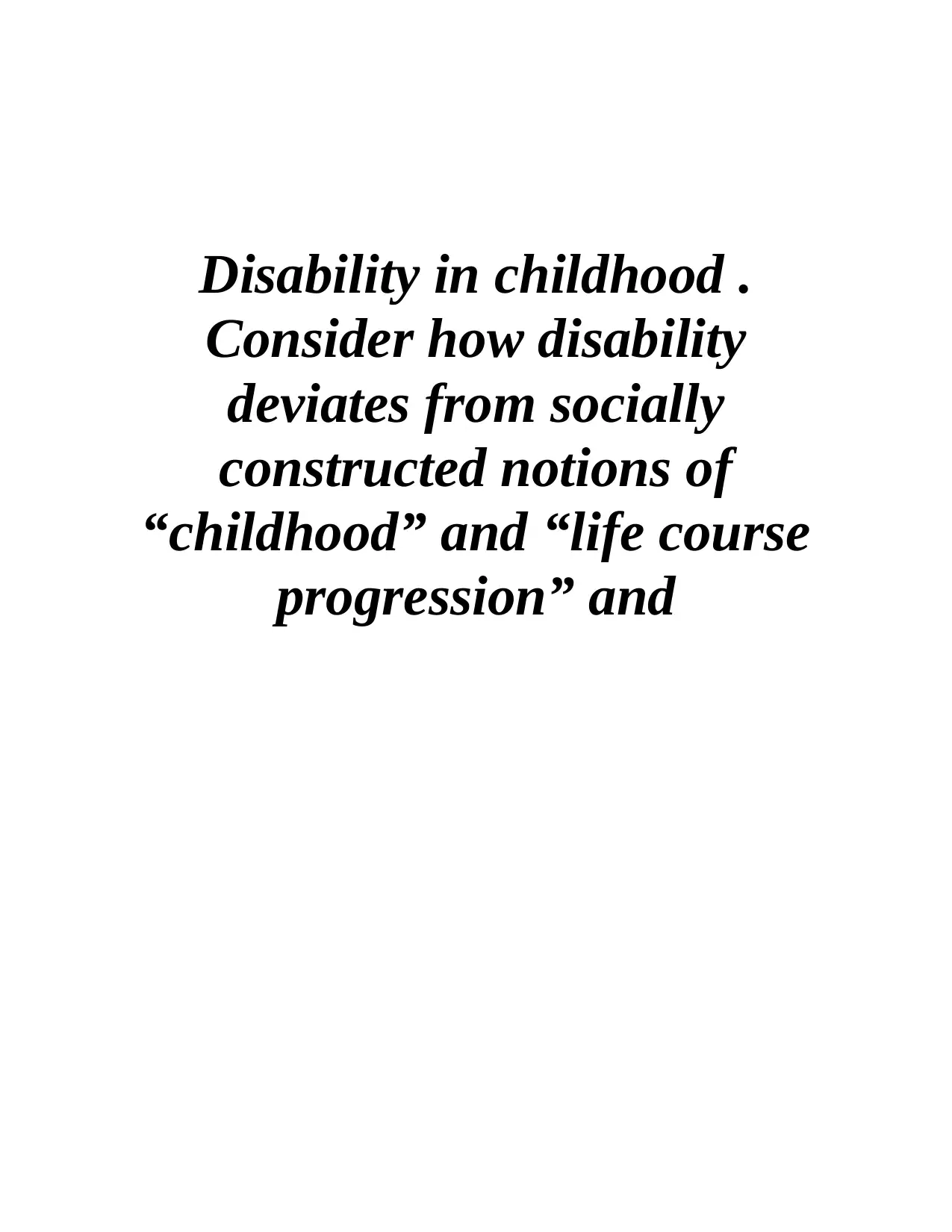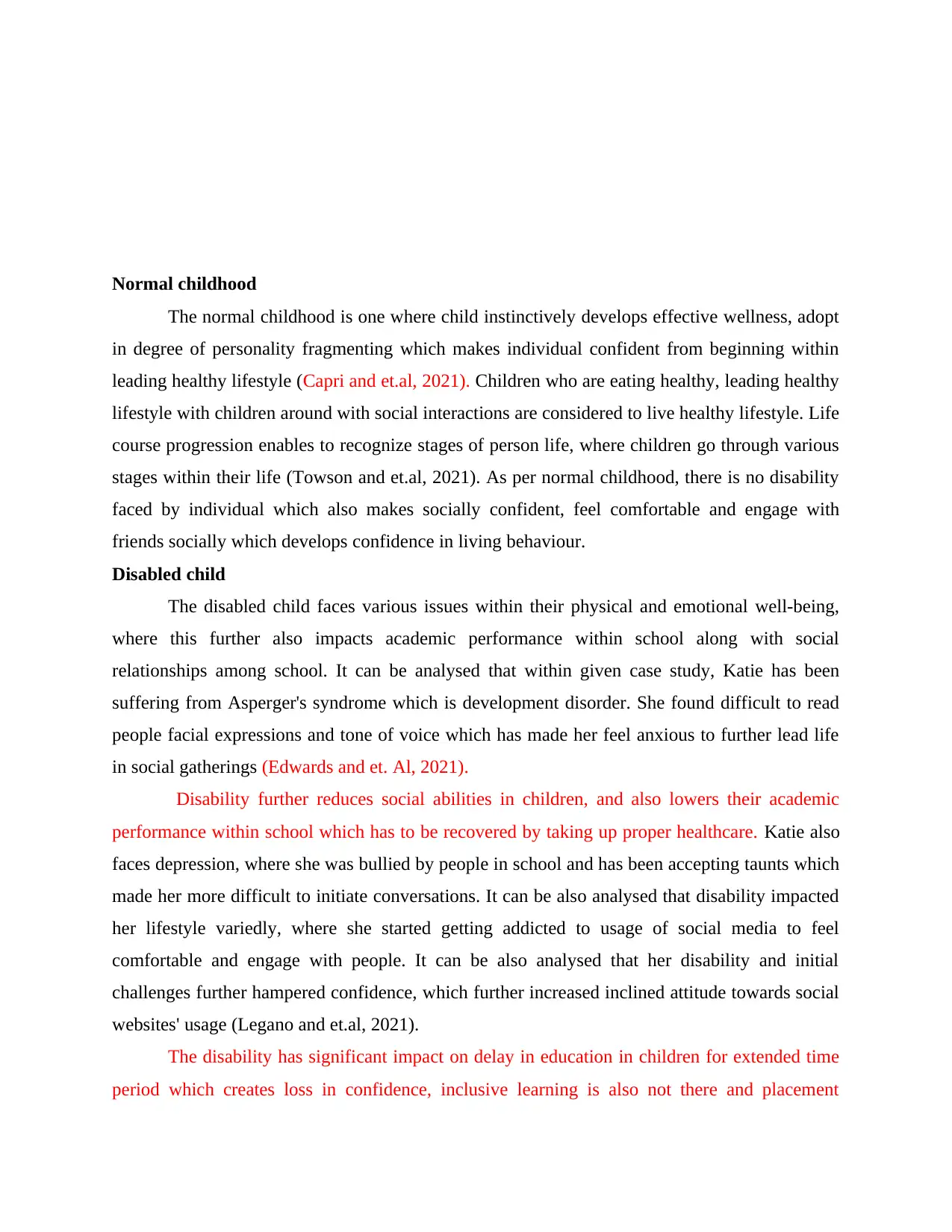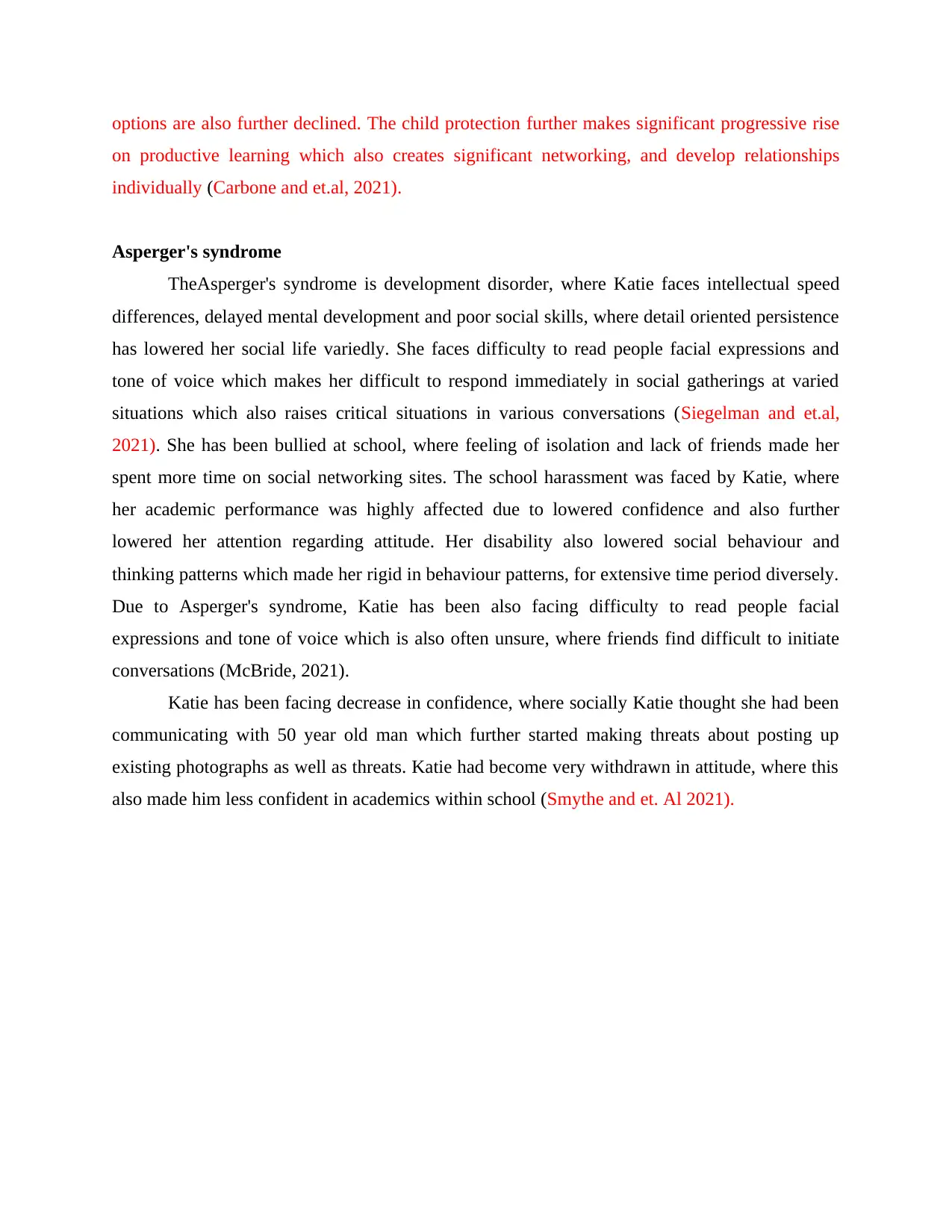Disability in Childhood: Social Constructs, Life Course & Case Study
VerifiedAdded on 2023/06/17
|4
|957
|427
Essay
AI Summary
This essay examines how disability in childhood deviates from socially constructed notions of "childhood" and "life course progression," focusing on a case study of a child with Asperger's syndrome. It contrasts the concept of a "normal childhood," characterized by healthy development and social interaction, with the challenges faced by disabled children, such as social difficulties, academic struggles, and emotional distress. The essay highlights how Asperger's syndrome, a developmental disorder, affects social skills, communication, and emotional well-being, leading to isolation and reliance on social media. It further discusses the impact of disability on education, confidence, and overall life opportunities, emphasizing the importance of inclusive learning and child protection. The case study of Katie, who experiences bullying and social anxiety due to Asperger's, illustrates the profound effects of disability on a child's life course.

Disability in childhood .
Consider how disability
deviates from socially
constructed notions of
“childhood” and “life course
progression” and
Consider how disability
deviates from socially
constructed notions of
“childhood” and “life course
progression” and
Paraphrase This Document
Need a fresh take? Get an instant paraphrase of this document with our AI Paraphraser

Normal childhood
The normal childhood is one where child instinctively develops effective wellness, adopt
in degree of personality fragmenting which makes individual confident from beginning within
leading healthy lifestyle (Capri and et.al, 2021). Children who are eating healthy, leading healthy
lifestyle with children around with social interactions are considered to live healthy lifestyle. Life
course progression enables to recognize stages of person life, where children go through various
stages within their life (Towson and et.al, 2021). As per normal childhood, there is no disability
faced by individual which also makes socially confident, feel comfortable and engage with
friends socially which develops confidence in living behaviour.
Disabled child
The disabled child faces various issues within their physical and emotional well-being,
where this further also impacts academic performance within school along with social
relationships among school. It can be analysed that within given case study, Katie has been
suffering from Asperger's syndrome which is development disorder. She found difficult to read
people facial expressions and tone of voice which has made her feel anxious to further lead life
in social gatherings (Edwards and et. Al, 2021).
Disability further reduces social abilities in children, and also lowers their academic
performance within school which has to be recovered by taking up proper healthcare. Katie also
faces depression, where she was bullied by people in school and has been accepting taunts which
made her more difficult to initiate conversations. It can be also analysed that disability impacted
her lifestyle variedly, where she started getting addicted to usage of social media to feel
comfortable and engage with people. It can be also analysed that her disability and initial
challenges further hampered confidence, which further increased inclined attitude towards social
websites' usage (Legano and et.al, 2021).
The disability has significant impact on delay in education in children for extended time
period which creates loss in confidence, inclusive learning is also not there and placement
The normal childhood is one where child instinctively develops effective wellness, adopt
in degree of personality fragmenting which makes individual confident from beginning within
leading healthy lifestyle (Capri and et.al, 2021). Children who are eating healthy, leading healthy
lifestyle with children around with social interactions are considered to live healthy lifestyle. Life
course progression enables to recognize stages of person life, where children go through various
stages within their life (Towson and et.al, 2021). As per normal childhood, there is no disability
faced by individual which also makes socially confident, feel comfortable and engage with
friends socially which develops confidence in living behaviour.
Disabled child
The disabled child faces various issues within their physical and emotional well-being,
where this further also impacts academic performance within school along with social
relationships among school. It can be analysed that within given case study, Katie has been
suffering from Asperger's syndrome which is development disorder. She found difficult to read
people facial expressions and tone of voice which has made her feel anxious to further lead life
in social gatherings (Edwards and et. Al, 2021).
Disability further reduces social abilities in children, and also lowers their academic
performance within school which has to be recovered by taking up proper healthcare. Katie also
faces depression, where she was bullied by people in school and has been accepting taunts which
made her more difficult to initiate conversations. It can be also analysed that disability impacted
her lifestyle variedly, where she started getting addicted to usage of social media to feel
comfortable and engage with people. It can be also analysed that her disability and initial
challenges further hampered confidence, which further increased inclined attitude towards social
websites' usage (Legano and et.al, 2021).
The disability has significant impact on delay in education in children for extended time
period which creates loss in confidence, inclusive learning is also not there and placement

options are also further declined. The child protection further makes significant progressive rise
on productive learning which also creates significant networking, and develop relationships
individually (Carbone and et.al, 2021).
Asperger's syndrome
TheAsperger's syndrome is development disorder, where Katie faces intellectual speed
differences, delayed mental development and poor social skills, where detail oriented persistence
has lowered her social life variedly. She faces difficulty to read people facial expressions and
tone of voice which makes her difficult to respond immediately in social gatherings at varied
situations which also raises critical situations in various conversations (Siegelman and et.al,
2021). She has been bullied at school, where feeling of isolation and lack of friends made her
spent more time on social networking sites. The school harassment was faced by Katie, where
her academic performance was highly affected due to lowered confidence and also further
lowered her attention regarding attitude. Her disability also lowered social behaviour and
thinking patterns which made her rigid in behaviour patterns, for extensive time period diversely.
Due to Asperger's syndrome, Katie has been also facing difficulty to read people facial
expressions and tone of voice which is also often unsure, where friends find difficult to initiate
conversations (McBride, 2021).
Katie has been facing decrease in confidence, where socially Katie thought she had been
communicating with 50 year old man which further started making threats about posting up
existing photographs as well as threats. Katie had become very withdrawn in attitude, where this
also made him less confident in academics within school (Smythe and et. Al 2021).
on productive learning which also creates significant networking, and develop relationships
individually (Carbone and et.al, 2021).
Asperger's syndrome
TheAsperger's syndrome is development disorder, where Katie faces intellectual speed
differences, delayed mental development and poor social skills, where detail oriented persistence
has lowered her social life variedly. She faces difficulty to read people facial expressions and
tone of voice which makes her difficult to respond immediately in social gatherings at varied
situations which also raises critical situations in various conversations (Siegelman and et.al,
2021). She has been bullied at school, where feeling of isolation and lack of friends made her
spent more time on social networking sites. The school harassment was faced by Katie, where
her academic performance was highly affected due to lowered confidence and also further
lowered her attention regarding attitude. Her disability also lowered social behaviour and
thinking patterns which made her rigid in behaviour patterns, for extensive time period diversely.
Due to Asperger's syndrome, Katie has been also facing difficulty to read people facial
expressions and tone of voice which is also often unsure, where friends find difficult to initiate
conversations (McBride, 2021).
Katie has been facing decrease in confidence, where socially Katie thought she had been
communicating with 50 year old man which further started making threats about posting up
existing photographs as well as threats. Katie had become very withdrawn in attitude, where this
also made him less confident in academics within school (Smythe and et. Al 2021).
⊘ This is a preview!⊘
Do you want full access?
Subscribe today to unlock all pages.

Trusted by 1+ million students worldwide

REFRENCES
Books and Journals
Capri, T., and et.al, 2021. Telerehabilitation for improving adaptive skills of children and young
adults with multiple disabilities: a systematic review. Review Journal of Autism and
Developmental Disorders, 8(2), pp.244-252.
Carbone, P. S and et.al, 2021. Promoting the Participation of Children and Adolescents With
Disabilities in Sports, Recreation, and Physical Activity. Pediatrics.
Edwards, B. M., and et. Al, 2021. Contextual strategies to support social inclusion for children
with and without disabilities in recreation. Disability and rehabilitation, 43(11),
pp.1615-1625.
Legano, L. A., and et.al,. (2021). Maltreatment of children with disabilities. Pediatrics. 147(5).
McBride, T. (2021). Minimizing the Impact of Asperger's Syndrome in the Classroom: Practical
Tips for Educators. In Teaching Gifted Children (pp. 501-506). Routledge.
Siegelman, N., and et.al, 2021. How you read affects what you gain: Individual differences in
the functional organization of the reading system predict intervention gains in
children with reading disabilities. Journal of Educational Psychology.
Smythe, T., and et. Al 2021. Early intervention for children with developmental disabilities in
low and middle-income countries–the case for action. International health, 13(3),
pp.222-231.
Towson, J. A and et.al, . (2021). Shared interactive book reading interventions for young children
with disabilities: A systematic review. American Journal of Speech-Language
Pathology, 1-16.
Books and Journals
Capri, T., and et.al, 2021. Telerehabilitation for improving adaptive skills of children and young
adults with multiple disabilities: a systematic review. Review Journal of Autism and
Developmental Disorders, 8(2), pp.244-252.
Carbone, P. S and et.al, 2021. Promoting the Participation of Children and Adolescents With
Disabilities in Sports, Recreation, and Physical Activity. Pediatrics.
Edwards, B. M., and et. Al, 2021. Contextual strategies to support social inclusion for children
with and without disabilities in recreation. Disability and rehabilitation, 43(11),
pp.1615-1625.
Legano, L. A., and et.al,. (2021). Maltreatment of children with disabilities. Pediatrics. 147(5).
McBride, T. (2021). Minimizing the Impact of Asperger's Syndrome in the Classroom: Practical
Tips for Educators. In Teaching Gifted Children (pp. 501-506). Routledge.
Siegelman, N., and et.al, 2021. How you read affects what you gain: Individual differences in
the functional organization of the reading system predict intervention gains in
children with reading disabilities. Journal of Educational Psychology.
Smythe, T., and et. Al 2021. Early intervention for children with developmental disabilities in
low and middle-income countries–the case for action. International health, 13(3),
pp.222-231.
Towson, J. A and et.al, . (2021). Shared interactive book reading interventions for young children
with disabilities: A systematic review. American Journal of Speech-Language
Pathology, 1-16.
1 out of 4
Related Documents
Your All-in-One AI-Powered Toolkit for Academic Success.
+13062052269
info@desklib.com
Available 24*7 on WhatsApp / Email
![[object Object]](/_next/static/media/star-bottom.7253800d.svg)
Unlock your academic potential
Copyright © 2020–2025 A2Z Services. All Rights Reserved. Developed and managed by ZUCOL.





